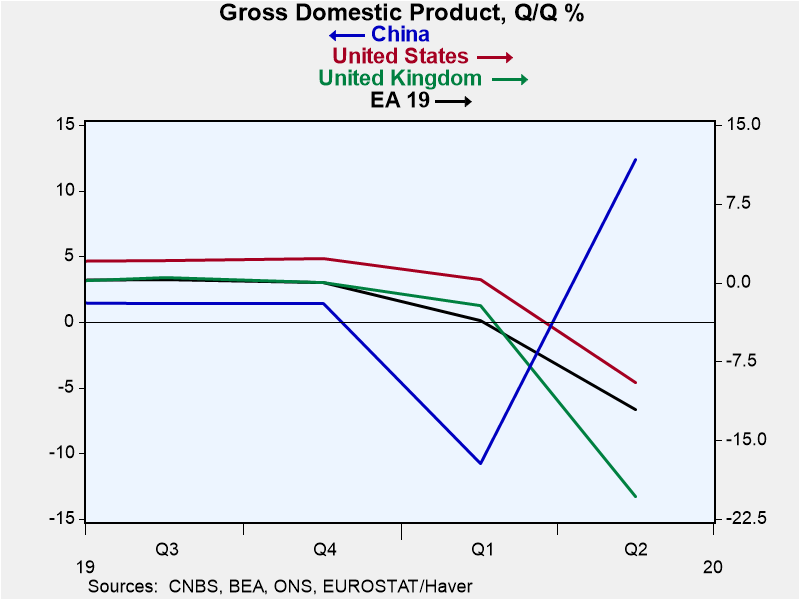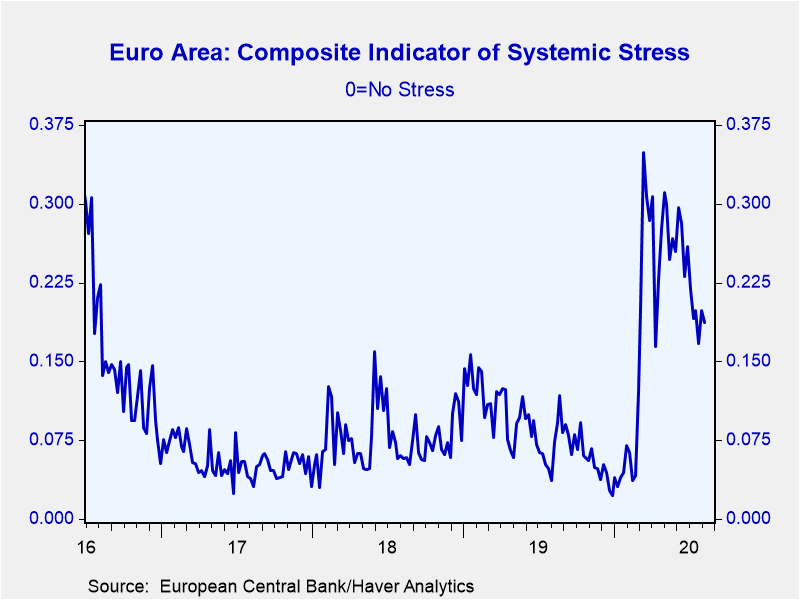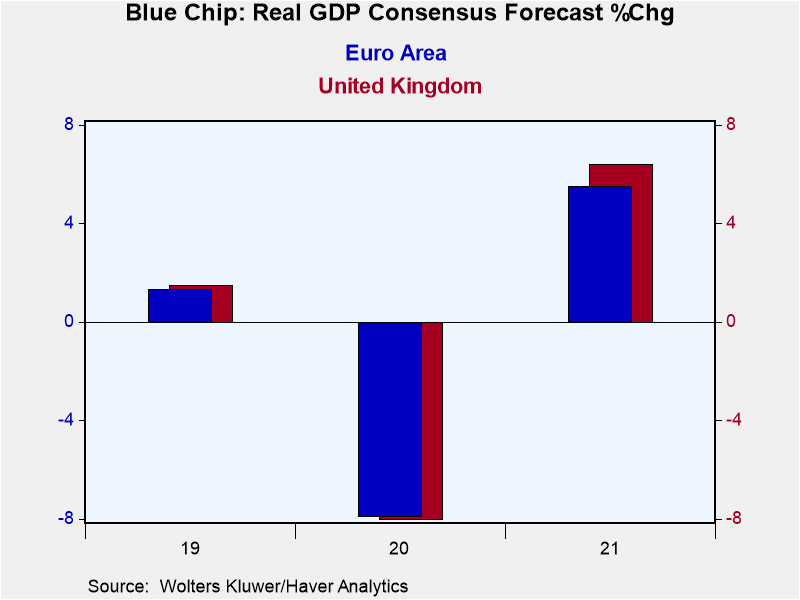 Global| Aug 13 2020
Global| Aug 13 2020Huge Holes in Europe with Limited Capacity to Climb Out Fast
by:Andrew Cates
|in:Viewpoints
Summary
Yesterday's release of Q2 GDP data in the UK has generated a more complete global picture of the economic devastation that's been generated by the Coronavirus pandemic. UK GDP specifically fell by 20.4% in Q2 which is the worst slump [...]
Yesterday's release of Q2 GDP data in the UK has generated a more complete global picture of the economic devastation that's been generated by the Coronavirus pandemic. UK GDP specifically fell by 20.4% in Q2 which is the worst slump on record. It compares unfavourably moreover with other major, albeit larger, economies. The US, for example, chalked up a retreat of 9.5% q/q while the Euro area contracted by 12.1%. China in contrast eked out a 12.4% q/q gain (see first chart). The timing and severity of the Coronavirus crisis in these economies, the size and nature of the policy response and the underlying exposure of various sectors to lockdown restrictions are all key to the reasons for the discrepancies in these Q2 growth rates. On the timing front, for example, China's GDP gain of 12.4% needs to be looked at relative to its GDP loss of 10.8% in Q1, in turn a manifestation of much earlier - and subsequent loosening of - lockdown restrictions. Equally the Euro area's GDP retreat of “only” 12.1% in Q2 needs to be set against an earlier albeit smaller contraction of 3.6% that in Q1. This was a function again of the earlier wave of the virus in countries such as Italy and Spain, relative to, say, the UK and the US.
Looking ahead what arguably matters now is firstly the size of the hole that economies find themselves in and secondly their ability to dig their way out. On the first of these, namely the size of their holes, our second figure below offers some perspective. This shows levels of GDP rebased to 2009 – a trough year for economic performance following the global financial crisis (GFC) – and with China contrasted on a different scale (given its much stronger growth performance over the past decade) compared with the more developed economies. This shows that Europe (i.e. the Eurozone and the UK) is arguably – at present – in a more worrisome position compared with the US and particularly China. For while the latter has already managed to overtake the output level that it reached prior to the Coronavirus crisis (in Q4 2019), GDP in both the UK and the Euro area has now fallen to levels that pre-dated the GFC. Specifically UK output is about 6% below its 2009 level while the Euro area's output is about 2.5% lower. The US is – at present – roughly half way between, with output that's around 13% above 2009 levels having been nearly 27% or so above that level in Q4 2019. For Europe though this means that having enacted a number of major policy initiatives, including of course extraordinarily loose monetary policy, and thus fostering a substantial, but necessary, bout of balance sheet deleveraging over the past 10 years, its economies now find themselves even worse off than when they kick-started that effort.
This inference of a wasted decade of economic repair is admittedly a little unfair. The economic consequences of the Coronavirus crisis have, after all, been deliberately engineered by various governments in order to deal with that crisis. They are not a direct consequence of excessive leverage and acute financial imbalances which were some of the hallmarks of the GFC. Unwinding those imbalances took time, effort and pain. One would hope that easing lockdown restrictions, ending social distancing and thereby returning to some semblance of economic normality will happen more quickly once the virus – with vaccine assistance – starts to fade.
But it almost goes without saying that absent that vaccine and there is little prospect that Europe will be digging itself out of its holes that fast. The latest data on case numbers do not make for pleasant reading as one by one Europe's economies have either already succumbed to, or are on the verge of, a second wave of the virus (see third and fourth charts below). The clear Catch 22 for the economy is that easing lockdown restrictions and reopening previously moribund sectors allows the virus to regain some traction. Reduced mobility (i.e. social distancing) has contained the virus but clamped down on economic activity. Heightened mobility, however, has obviously fed the virus again.
In the meantime, the normal channels via which one might anticipate moving the wheels of an economic recovery are either hampered or missing in action. Europe's financial markets, for example, are still fairly stressed compared with recovery norms of the past notwithstanding tremendous efforts from Central Banks to unlock the wheels of credit. As evidence for this the ECB's composite indicator of systemic stress in financial markets is still a long way from prior norms (see fifth chart below).
The wheels of household income growth are also at risk of stalling and going into reverse from the current and prospective wave of labour market instability. Government furlough schemes have been an important reason why those wheels have been turning in recent weeks but some of these schemes, and most notably the UK's, are destined to wind down in the coming months. The issue here of course is that, as those schemes come off and household incomes are drained, an important source of support for other sectors that are reliant on consumer spending will begin to feel more pain.
Against this backdrop it is little wonder that many economists remain somewhat gloomy about the economic destiny of many of Europe's economies. The latest August snapshot from the Blue Chip Economic Indicators Panel does not envisage that the Euro area and the UK will regain their prior pre-Coronavirus level of output until at least Q1 2022 (see final chart below). Moreover, the risks to this at present seem to be skewed toward the later rather than the sooner.
Viewpoint commentaries are the opinions of the author and do not reflect the views of Haver Analytics.Andrew Cates
AuthorMore in Author Profile »Andy Cates joined Haver Analytics as a Senior Economist in 2020. Andy has more than 25 years of experience forecasting the global economic outlook and in assessing the implications for policy settings and financial markets. He has held various senior positions in London in a number of Investment Banks including as Head of Developed Markets Economics at Nomura and as Chief Eurozone Economist at RBS. These followed a spell of 21 years as Senior International Economist at UBS, 5 of which were spent in Singapore. Prior to his time in financial services Andy was a UK economist at HM Treasury in London holding positions in the domestic forecasting and macroeconomic modelling units. He has a BA in Economics from the University of York and an MSc in Economics and Econometrics from the University of Southampton.








